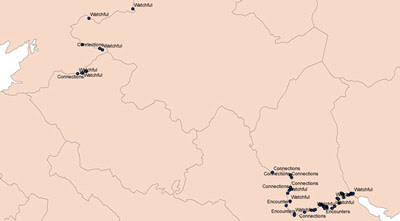 Image: Donovan Wylie. Tower Golf 40, south Armagh, west view. Wylie is represented by Magnum. www.magnumphotos.com
Image: Donovan Wylie. Tower Golf 40, south Armagh, west view. Wylie is represented by Magnum. www.magnumphotos.comI went to the Ministry of Defence and requested the exact locations of British Military structures along the Border in the last thirty years. These will be just one of the defensive features marked on the Map of Watchful Architecture. I put in my request under the Freedom of Information Act. This was an act of parliament that introduced a public ‘right to know’ in relation to public bodies. It was a Labour Party commitment in 1997’s general election and came into force in 2005. Their manifesto said: "We are pledged to a Freedom of Information Act, leading to more open government."
Under the terms of the Act I had to be given the information within 20 days. I was.
The reply letter, that came with the spreadsheet of grid locations, was very politely worded. I was thanked for my request, they were “pleased to enclose” the information, and I was told how to complain if I am dissatisfied. It feels very New Labour all right. Searching around online I see that a criticism of the
 Act is that its range of exemptions is uncommonly wide, compared with other democracies, and there is a ministerial veto that can undermine the Act any time.
Act is that its range of exemptions is uncommonly wide, compared with other democracies, and there is a ministerial veto that can undermine the Act any time.However, I’m not going to be too critical now. The existence of a one-stop Act for all your information requests is a very useful facility. Even if your requested is refused you will know why. That at least means you will be in direct debate with the public body and not just in a Kafkaesque process of being sent on to some other office and never getting anywhere. The Freedom of Information Act is democracy at work.
Next: I want to find out where the Republic of Ireland’s police force perform checks for illegal immigration from the UK. I know it happens on the motorway between Belfast and Dublin. Often when I take a bus south we are pulled over and all the passengers checked. But does it happen on other Border roads? And if so, which?





















